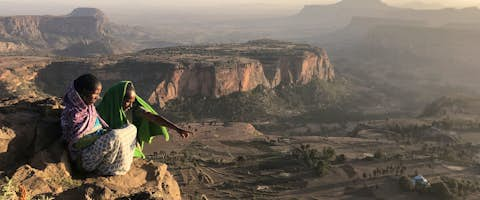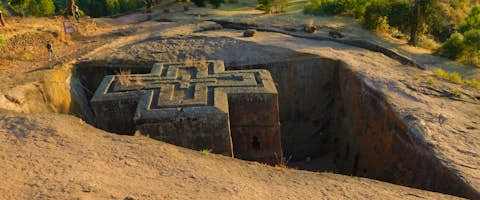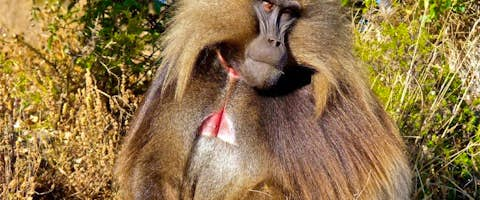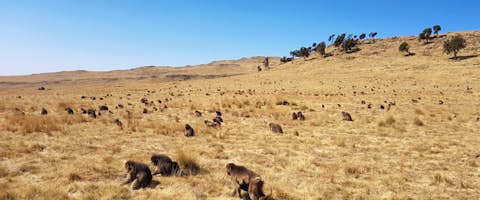The Gelada Monkey
Gelada monkeys are quite baboon-like, with golden manes and elongated faces. This has led to them inaccurately being called ‘gelada baboons’ - but are in fact monkeys - and the only species of grass-grazing primates left, the rest having been wiped out when the climate warmed around a million years ago.
Apart from humans, they are the world’s most terrestrial primates.
Gelada monkeys have fascinating and complex social structures. They reside in packs of up to 1,200 monkeys, a truly astonishing sight when they are on the move. Within the packs, there are dominant males who have ‘harems’, with around 12 females that they mate with. Lurking on the outskirts are rather amusingly glum-looking groups of bachelor males.
Occasionally, a fight will take place between one - or several - of the bachelor males and a dominant male over ownership of the harem.
This is often started by the dominant males, who signals the challenge through an elaborate protocol of macho showmanship that includes emitting high-pitched noises and shaking the branches of a tree while shrieking.
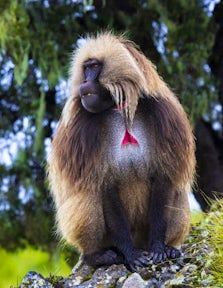
These fights can last for days and are often brutal - the males have long, sharp teeth - and sometimes end with one of the monkeys being mortally wounded. Sometimes, however, one side will retreat when the game is up.
If it is the dominant male who loses, they may stay with the harem but in a kind of grandfather role, looking after the young but not mating with the females. His red patch will also lighten to become pink - the intensity of the colour is dictated by the strength of the monkeys’ hormone levels.
Another interesting element of their behaviour is the fact that they sleep on cliff edges at night. Fearing being picked off in their sleep by a predator such as a leopard if they sleep on flat ground, they spend the night on ledges which they are able to climb easily thanks to their short, stubby fingers, but where such predators would struggle.
The monkeys are highly sociable. They spend much of their days (often through noisy barks and cries) forming connections with other monkeys and grooming one another, unlike many other, more sedate primate species.
There is a strict hierarchy within their societies between the dominant male and others, but also between dominant and submissive females. One of their behaviours is particularly human - they enjoy spending several hours in the morning sunbathing.
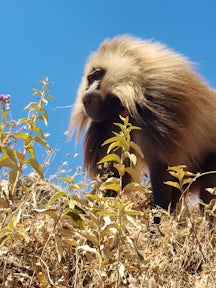
Gelada monkeys are not an endangered species, however their numbers have dwindled in recent decades. Tourism can play an important role in ensuring that their numbers remain stable by providing a steady source of income to often impoverished local communities.
This provides the necessary incentive for the conservation of natural areas that might otherwise be destroyed by agriculture and infrastructure projects.
The best place to find Gelada monkeys in Ethiopia is in the highlands of the Simien Mountains National Park.
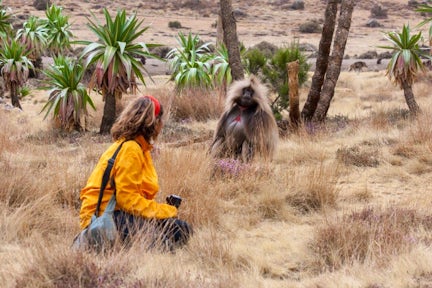
Sitting amongst Geladas and Juniper trees.
Visit Gelada Monkeys on these trips
Ready to plan your Ethiopia adventure?
Listen
We'll spend some time listening to your aspirations, then discuss the kind of experience that might suit you.
Match
Next we'll discuss the options, shortlist the best trips for you and present you our impartial recommendations.
Reserve
We'll place a 24 hour hold on your preferred option - without obligation - whilst we talk through the details.
Whatever your budget, group size, length of stay, preferred activity or appetite for adventure, we can help.
+1 315 645 2889




